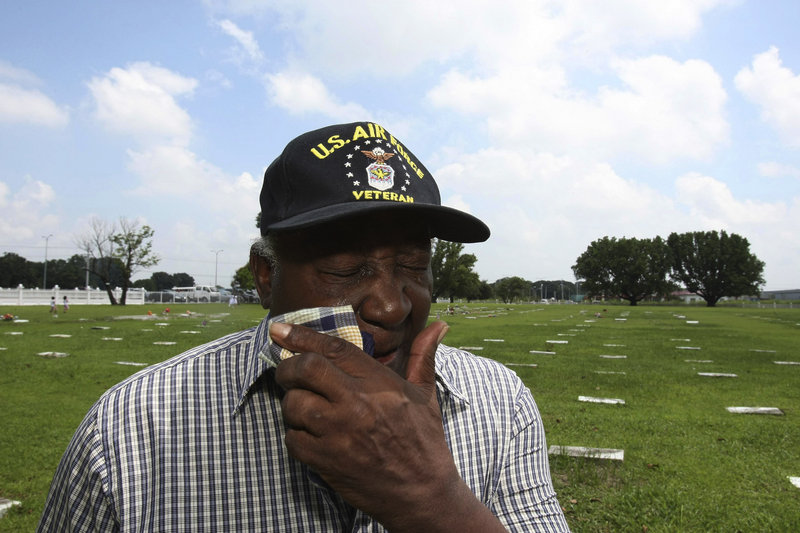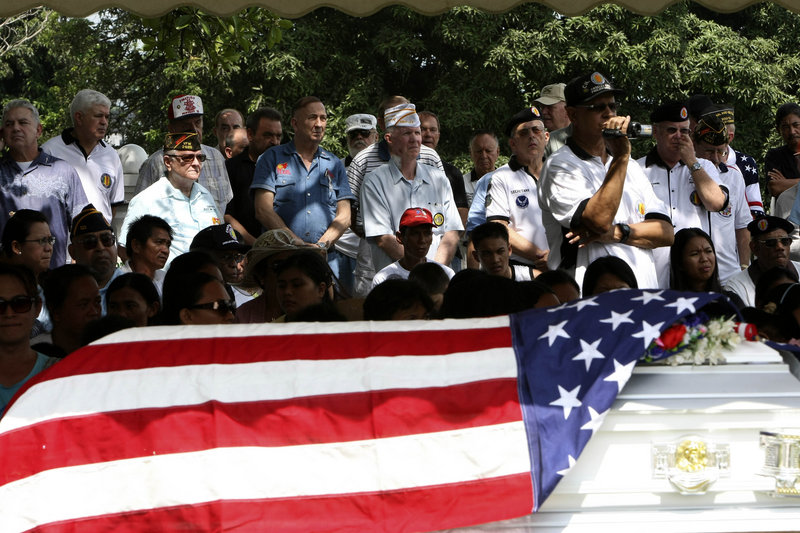CLARK, Philippines – Walking along the rows of tombstones here offers a glimpse of the wars America has fought and the men and women who waged them. But most of the grave markers have been half-buried for 20 years, and there is little hope that the volcanic ash obscuring names, dates and epitaphs will be cleared any time soon.
Clark Veterans Cemetery was consigned to oblivion in 1991, when Mount Pinatubo’s gigantic eruption forced the United States to abandon the sprawling air base surrounding it. Retired U.S. soldiers, Marines and sailors volunteer to keep watch, relying on donations to try to maintain the grounds, but they lament that they’re helplessly short on funds to fix things, and that Washington is unwilling to help.
“It’s the veterans’ cemetery that America forgot,” Vietnam War veteran and ex-Navy officer Robert Chesko said.
As America marked Independence Day, the U.S. veterans who collect funds to care for the cemetery renewed their calls for Washington to fund and take charge of the work.
Workers at the cemetery north of Manila recently dug to fully expose a gravestone for an Army sergeant who died in World War II in the Philippines. They discovered his wife’s name engraved under his and a long-hidden tribute: “Daughter, sister, wife and mother of veterans.”
It’s impossible to say what else remains hidden at the 17-acre cemetery. It holds the remains of 8,600 people, including 2,200 American veterans and nearly 700 allied Philippine Scouts who saw battle in conflicts from the early 1900s to the resistance against brutal Japanese occupation troops in World War II.
Clark’s dead also include military dependents, civilians who worked for the U.S. wartime government and at least 2,139 mostly unidentified soldiers whose marble tombstones are labeled “Unknown.”
“People celebrate on the Fourth of July, but they forgot the 8,600 who helped make that freedom happen,” said former Navy Capt. Dennis Wright, who saw action in Vietnam and is now a business executive.
“We’re trying to get the U.S. government to assume responsibility for maintaining the cemetery so we can get it up to standards … not on nickels and dimes and donations and gifts,” said retired Air Force Chief Master Sgt. Larry Heilhecker, who served as cemetery caretaker for five years until last month.
Clark was a U.S. base for nearly a century and was once the largest American Air Force installation off the U.S. mainland. It served as a key staging area for U.S. forces during the Korean and Vietnam wars.
The Clark cemetery, which can accommodate at least 12,000 remains, was developed between 1947 and 1950, when it was used to collect the remains and tombstones from four U.S. military cemeteries as American officials sorted out their dead from World War II and previous wars.
An American cemetery at the then-Fort McKinley in Manila became the exclusive burial ground for all Americans and allied Philippine Scouts who were killed in World War II combat. The 152-acre Manila cemetery collected 17,202 dead, the largest number of American casualties interred in one place from the last world war.
Now closed to burials, the stunningly landscaped Manila cemetery became one of 24 American burial grounds outside the U.S. mainland. Nearly 125,000 Americans who perished in World Wars I and II and the Mexican War are interred in those U.S.-funded overseas cemeteries, regarded as among the most beautiful war memorials in the world. The overseas burial sites are administered by the American Battle Monuments Commission, or ABMC.
The dead at Clark are not limited to World War II casualties — they date as far back as 1900. Also unlike the Manila cemetery, it continues to accept burials. One U.S. veteran who lives in the area had his son buried here after he was killed in Iraq in 2004. But Clark is not administered by the ABMC.
The Air Force managed Clark cemetery from 1947 to 1991, when it abruptly left after nearby Pinatubo roared back to life from a 500-year slumber. Even before the eruption, negotiations with the Philippine government for a new U.S. military lease on Clark had bogged down after nearly a century of presence in the Philippines.
Philippine authorities failed to look after the cemetery. In 1994, American veterans were shocked to find it had become an ash-covered jungle of weeds, overgrown grass and debris. Half of its old steel fence had been looted.
Today, a pair of U.S. and Philippine flags flutter in the wind over the graves. A recently restored marble obelisk, pockmarked by World War II gun and artillery fire, venerates the unknown dead. A small sign at a new steel gate ushers in visitors with a tribute to the war dead: “Served with honor.”
All the improvements came from donations. Wright’s company spent $90,000 to build a new concrete and steel fence and a parking lot and make other improvements. An old veteran, confined to a nursing home in Florida, sent one dollar in a touching act, Heilhecker said.
Retired Air Force Tech. Sgt. Littleton J. Fortune has been giving small amounts from his pension for the upkeep of the cemetery, where many of his friends lay. He said the worst day in his life came in 2004 when his son, a young Army sergeant, was killed by a bomb in Iraq. He buried his son at Clark and continues to help the cemetery.
Still, the Clark gravesites look forlorn compared to the American cemetery in Manila.
Dashing the hopes of the American veterans, the ABMC and the Department of Veterans Affairs, which manages 131 U.S. mainland cemeteries through an agency, both said Clark was outside their mandate.
U.S. Ambassador to Manila Harry Thomas, who has visited the Clark cemetery twice, praised the American veterans for looking after the burial grounds, which he said volunteer embassy staff and visiting U.S. sailors have helped clean up. But he said the U.S. Congress only appropriates funds for official cemeteries overseas through the ABMC.
The new cemetery caretaker, John Gilbert, said the veterans are not trying to pass the responsibility.
“We’re proud to do it, don’t get me wrong, but we do not have the resources to do it,” Gilbert said. “We are not ready to let this cemetery be taken back by the jungle. If we have to do it ourselves, we will do it.
“We don’t leave our brothers behind.”
Send questions/comments to the editors.




Success. Please wait for the page to reload. If the page does not reload within 5 seconds, please refresh the page.
Enter your email and password to access comments.
Hi, to comment on stories you must . This profile is in addition to your subscription and website login.
Already have a commenting profile? .
Invalid username/password.
Please check your email to confirm and complete your registration.
Only subscribers are eligible to post comments. Please subscribe or login first for digital access. Here’s why.
Use the form below to reset your password. When you've submitted your account email, we will send an email with a reset code.